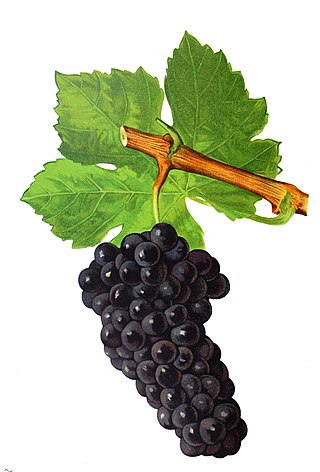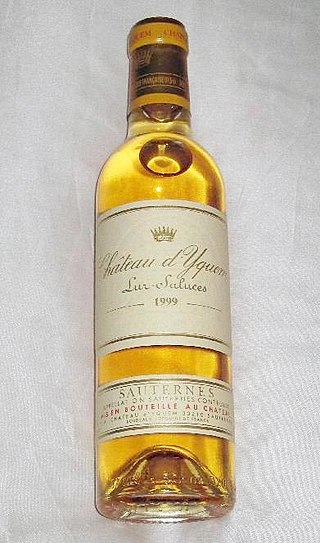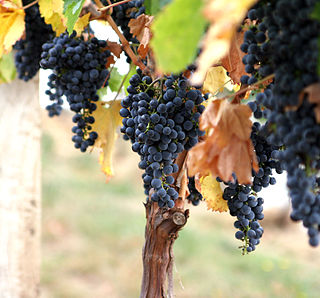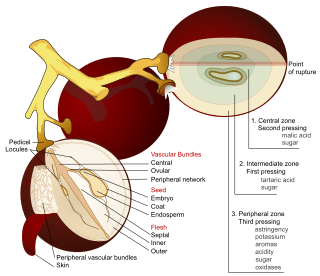Shiraz wine refers to two different wines. Historically, the name refers to the wine produced around the city of Shiraz in Iran. [1] [2] In the current era, "Shiraz" is an alternative name for the Syrah grape, mostly used in Australia and South Africa. The modern "Shiraz" grape is identical to Syrah and originated in southeast France with no established connection to the city of Shiraz. [3]
By the ninth century, the city of Shiraz had established a reputation for producing the finest wine in the world, [1] and was Iran's wine capital. The export of Shiraz wine by European merchants in the 17th century has been documented. As described by enthusiastic English and French travellers to the region in the 17th to 19th centuries, the wine grown close to the city was of a more dilute character due to irrigation, while the best[ according to whom? ] Shiraz wines were actually grown in terraced vineyards around the village of Khollar. These wines were white and existed in two different styles: dry wines for drinking young, and sweet wines meant for aging. The latter wines were compared to "an old sherry" (one of the most prized European wines of the day), and at five years of age were said to have a fine bouquet and nutty flavour. The dry white Shiraz wines (but not the sweet ones) were fermented with significant stem contact, which should have made these wines rich in tannins. [1]
While travellers have described the wines as white, there seem to be no ampelographic descriptions of the vines or grapes. Marco Polo made mention of the wine, and other classical accounts describe vines trained by pulleys and weights to grow up one side of a house and down another. [4]
The British poet Edward FitzGerald later translated the Rubaiyat of Omar Khayyam from Persian language, in which praise is heaped on the Shiraz wines.
In modern Iran, Shiraz wine cannot be produced legally due to the prohibition of alcohol in Islam. Before the Islamic Revolution in 1979, there were up to 300 wineries in Iran; now there are none. As a whole, Iran is no longer a wine-producing country, but Iranian Christians are legally allowed to ferment wine. [5]
Despite the name, there is no proven connection between the city of Shiraz and the modern-day red grape variety "Shiraz", planted in Australia, South Africa, Argentina, Canada, the United States, and some other countries. [6] [7] The modern Shiraz grape, now known to be identical to the Syrah grape, was brought to Australia by James Busby, the father of Australian wine. Busby travelled through Spain and France collecting vine cuttings that were the foundation of the Australian wine industry.

Fortified wine is a wine to which a distilled spirit, usually brandy, has been added. In the course of some centuries, winemakers have developed many different styles of fortified wine, including port, sherry, madeira, Marsala, Commandaria wine, and the aromatised wine vermouth.

Syrah, also known as Shiraz, is a dark-skinned grape variety grown throughout the world and used primarily to produce red wine. In 1999, Syrah was found to be the offspring of two obscure grapes from southeastern France, Dureza and Mondeuse Blanche. Syrah should not be confused with Petite Sirah, a cross of Syrah with Peloursin dating from 1880.

Marsanne is a white wine grape, most commonly found in the Northern Rhône region. It is often blended with Roussanne. In Savoie the grape is known as grosse roussette. Outside France it is also grown in Switzerland, Spain, Australia, New Zealand, Canada and the United States.

Durif is a variety of red wine grape primarily grown in Australia, California, France, and Israel. Since the end of the 20th century, wineries located in Washington's Yakima River Valley, Maryland, Arizona, Texas, West Virginia, Chile, Mexico's Baja California Peninsula, and Ontario's Niagara Peninsula have also produced wines from Durif grapes. It is the main grape known in the U.S. and Israel as Petite Sirah, with over 90% of the California plantings labeled "Petite Sirah" being Durif grapes; the U.S. Bureau of Alcohol, Tobacco, Firearms and Explosives (ATF) recognizes "Durif" and "Petite Sirah" as synonyms for the same grape. It produces tannic wines with a spicy, plummy flavour. The grape originated as a cross of Syrah pollen germinating a Peloursin plant. On some occasions, Peloursin and Syrah vines may be called Petite Sirah, usually because the varieties are extremely difficult to distinguish in old age.

Viognier is a white wine grape variety. It is the only permitted grape for the French wine Condrieu in the Rhône Valley.

Mourvèdre is a red wine grape variety grown in many regions around the world including the Rhône and Provence regions of France, the Valencia and Jumilla and Yecla denominaciones de origen (DOs) of Spain, as well as the Balearic Islands, California and Washington and the Australian regions of South Australia and New South Wales, plus South Africa. In addition to making red varietal wines, Mourvèdre is a prominent component in "GSM" blends. The variety is also used to make rosé and port-style fortified wines.

Collioure is an Appellation d'Origine Contrôlée (AOC) for French wines situated around the town of Collioure in the Roussillon wine region of France. Red, rosé and a few white wines are produced-the reds from Grenache noir, Mourvèdre, Syrah, Carignan and Cinsaut grapes; the white are made from a blend of Grenache blanc and Grenache gris. The boundaries of the AOC are identical with the Banyuls AOC as many of the grapes grown in Collioure are destined for use in the fortified Vins doux naturels of the region. The grapes that do not get used for Banyuls are then produced as non-fortified still wines under the Collioure AOC.

Tannat is a red wine grape, historically grown in South West France in the Madiran AOC, and is now one of the most prominent grapes in Uruguay, where it is considered the "national grape".

The Australian wine industry is one of the world's largest exporters of wine, with approximately 800 million out of the 1.2 to 1.3 billion litres produced annually exported to overseas markets. The wine industry is a significant contributor to the Australian economy through production, employment, export, and tourism.

Sauternes is a French sweet wine from the region of the same name in the Graves section in Bordeaux. Sauternes wine is made from Sémillon, sauvignon blanc, and muscadelle grapes that have been affected by Botrytis cinerea, also known as noble rot. This causes the grapes to become partially raisined, resulting in concentrated and distinctively flavored wines. Due to its climate, Sauternes is one of the few wine regions where infection with noble rot is a frequent occurrence. Even so, production is a hit-or-miss proposition, with widely varying harvests from vintage to vintage. Wines from Sauternes, especially the Premier Cru Supérieur estate Château d'Yquem, can be very expensive, largely due to the very high cost of production. Barsac lies within Sauternes and is entitled to use either name. Somewhat similar but less expensive and typically less-distinguished wines are produced in the neighboring regions of Monbazillac, Cérons, Loupiac and Cadillac. In the United States, there is a semi-generic label for sweet white dessert wines known as sauterne without the "s" at the end and uncapitalized.

Mondeuse noire is a red French wine grape variety that is grown primarily in the Savoy region of eastern France. The grape can also be found in Argentina, Australia, California, Switzerland and Sicily. Plantings of Mondeuse noire was hit hard during the phylloxera epidemic of the mid to late 19th century which nearly wiped out the vine from eastern France. While the grape recovered slightly in the 20th century, French plantations of Mondeuse noire fell sharply in the 1970s, with just over 200 hectares left in France in 2000. In the early 21st century, it seems the variety has increased somewhat in popularity, as it can give good wines if the planting site is chosen carefully.

Namibian wine is produced in small quantities by a few wineries. Although the production of wine is expanding in Namibia, the grapes grown in the country are mostly destined for use as table grapes for export to Europe rather than for wine. One of the challenges of viticulture in Namibia is that the country is quite dry, which means that irrigation is usually necessary. Unlike its southern neighbour, South Africa, it is also situated closer to the equator than the traditional "30 to 50 degrees latitude" rule of thumb of areas suitable for wine production.

Lesbos wine is wine made on the Greek island of Lesbos in the Aegean Sea. The island has a long history of winemaking dating back to at least the 7th century BC when it was mentioned in the works of Homer. During this time the area competed with the wines of Chios for the Greek market. An apocryphal account details one of the brothers of the poet Sappho as a merchant trading Lesbos wine with the Greek colony of Naucratis in Egypt. The most noted Lesbos wine was known as Pramnian which draws similarities today to the Hungarian wine Eszencia. The popularity of Lesbos wine continued into Roman times where it was highly valued along with other Aegean wines of Chios, Thasos and Kos.

Petit Manseng is a white wine grape variety that is grown primarily in South West France. It produces the highest quality wine of any grape in the Manseng family. The name is derived from its small, thick skin berries. Coupled with the small yields of the grapevine, most Petit Manseng farmers produce around 15 hl of wine per hectare. The grape is often left on the vine till December to produce a late harvest dessert wine. It can develop high sugar level while maintaining acidity, so it is usually incorporated into sweet wines of Jurançon and Pacherenc du Vic-Bilh. The grape is grown primarily in Gascony, Jurançon and around Madiran but has recently drawn interest in New World wine regions like California, North Georgia, Virginia, and Ohio. In May 2020, CSIRO scientists discovered through DNA analysis that Australia's plantings of Petit Manseng, first imported in 1979, are in fact Gros Manseng. The reason is that it is expected to follow Viognier's path to popularity among white wine drinkers. It was already present in Uruguay, when Basque settlers brought "Manseng" and Tannat vines with them to their new home. Despite being easily recognizable as a white grape while true Manseng is a black grape, wine that is Petit Manseng is still normally labeled as just "Manseng". The grape is often left on the vine to produce a late harvest wine made from its nearly raisin like grapes.

New South Wales wine is Australian wine produced in New South Wales, Australia. New South Wales is Australia's most populous state and its wine consumption far outpaces the region's wine production. The Hunter Valley, located 130 km (81 mi) north of Sydney, is the most well-known wine region but the majority of the state's production takes place in the Big Rivers zone-Perricoota, Riverina and along the Darling and Murray Rivers. The wines produced from the Big Rivers zone are largely used in box wine and mass-produced wine brands such as Yellow Tail. A large variety of grapes are grown in New South Wales, including Cabernet Sauvignon, Chardonnay, Shiraz and Sémillon.

Dureza is a dark-skinned French wine grape variety from the Ardèche department of south central France in the Auvergne-Rhône-Alpes region. The grape is most widely known for being the father vine of Syrah—a discovery that confirmed that the Syrah vine was native to France and not introduced to the country from Persia, Sicily, Egypt or elsewhere, as had been speculated.

The annual growth cycle of grapevines is the process that takes place in the vineyard each year, beginning with bud break in the spring and culminating in leaf fall in autumn followed by winter dormancy. From a winemaking perspective, each step in the process plays a vital role in the development of grapes with ideal characteristics for making wine. Viticulturalists and vineyard managers monitor the effect of climate, vine disease and pests in facilitating or impeding the vine's progression from bud break, flowering, fruit set, veraison, harvesting, leaf fall and dormancy – reacting if need be with the use of viticultural practices like canopy management, irrigation, vine training and the use of agrochemicals. The stages of the annual growth cycle usually become observable within the first year of a vine's life. The amount of time spent at each stage of the growth cycle depends on a number of factors – most notably the type of climate and the characteristics of the grape variety.

The acids in wine are an important component in both winemaking and the finished product of wine. They are present in both grapes and wine, having direct influences on the color, balance and taste of the wine as well as the growth and vitality of yeast during fermentation and protecting the wine from bacteria. The measure of the amount of acidity in wine is known as the “titratable acidity” or “total acidity”, which refers to the test that yields the total of all acids present, while strength of acidity is measured according to pH, with most wines having a pH between 2.9 and 3.9. Generally, the lower the pH, the higher the acidity in the wine. There is no direct connection between total acidity and pH. In wine tasting, the term “acidity” refers to the fresh, tart and sour attributes of the wine which are evaluated in relation to how well the acidity balances out the sweetness and bitter components of the wine such as tannins. Three primary acids are found in wine grapes: tartaric, malic, and citric acids. During the course of winemaking and in the finished wines, acetic, butyric, lactic, and succinic acids can play significant roles. Most of the acids involved with wine are fixed acids with the notable exception of acetic acid, mostly found in vinegar, which is volatile and can contribute to the wine fault known as volatile acidity. Sometimes, additional acids, such as ascorbic, sorbic and sulfurous acids, are used in winemaking.

The Barossa Valley wine region is one of Australia's oldest and most premier wine regions. Located in South Australia, the Barossa Valley is about 56 km northeast of the city of Adelaide. Unlike most of Australia whose wine industry was heavily influenced by the British, the wine industry of the Barossa Valley was founded by German settlers fleeing persecution from the Prussian province of Silesia. The warm continental climate of the region promoted the production of very ripe grapes that was the linchpin of the early Australian fortified wine industry. As the modern Australian wine industry shifted towards red table wines in the mid-20th century, the Barossa Valley fell out of favor due to its reputation for being largely a Syrah from producers whose grapes were destined for blending. During this period the name "Barossa Valley" rarely appeared on wine labels. In the 1980s, the emergence of several boutique families specializing in old vine Shiraz wines began to capture international attention for the distinctive style of Barossa Shiraz, a full bodied red wine with rich chocolate and spice notes. This led to a renaissance in the Barossa Valley which catapulted the region to the forefront of the Australian wine industry.
Co-fermentation is the practice in winemaking of fermenting two or more fruits at the same time when producing a wine. This differs from the more common practice of blending separate wine components into a cuvée after fermentation. While co-fermentation in principle could be practiced for any mixture of grape varieties or other fruits, it is today more common for red wines produced from a mixture of red grape varieties and a smaller proportion of white grape varieties.